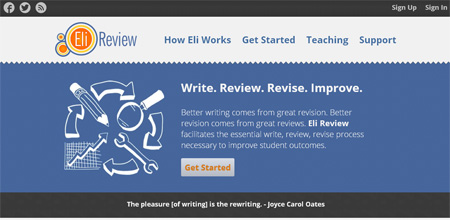by Kristine Pytash
 The PEW Internet & American Life Project recently produced the report, The Impact of Digital Tools on Student Writing and How Writing is Taught in Schools (2013). In this report, 2,462 Advanced Placement (AP) and National Writing Project (NWP) teachers from middle and high school classrooms were surveyed about the role of technology in the teaching of writing.
The PEW Internet & American Life Project recently produced the report, The Impact of Digital Tools on Student Writing and How Writing is Taught in Schools (2013). In this report, 2,462 Advanced Placement (AP) and National Writing Project (NWP) teachers from middle and high school classrooms were surveyed about the role of technology in the teaching of writing.
While the report provides a range of information, this blog will examine two significant points. First, with advances in digital media and technology comes a very important question: how are teachers defining writing? Second, when teachers do use technology during writing instruction, what do they think are the benefits for students learning?
Technology can be used to facilitate writing instruction. For example, platforms such as Eli Review allow students to upload papers for peer review and feedback. But technology has also redefined writing. Composing with audio, video, games, and images allows students to create multimodal writings. One of the interesting aspects of this report was that for the teachers a “conceptual divide” still exists between what teachers consider “formal” writing and “informal” writing (p. 17). Formal writing was confined to typical school writing assignments, such as journal entries and research reports while texting, blogs, and tweets were considered informal writings. Teachers did note that these types of informal writings are important and can even spur longer, more formal pieces. It seems that for some teachers, a divide still exists between the writing students do in their daily lives versus what will be valued in colleges and workplace settings.

Despite the debate between what constitutes formal and informal writing, teachers acknowledged that digital tools provide important affordances. According to teachers, technology and digital tools are making it easier for students to engage a wide range of readers allowing them to learn more about how purpose and audience drive writing. Teachers also noted that technology provided more opportunities for students to collaborate on writing assignments. Finally, teachers reported that technology provides students with opportunities to be creative as compositions that include audio, visuals, including remixes, provide students with a variety of mediums for self-expression. These are typically areas of writing instruction that can be challenging to teach.
While the report surveyed a variety of teachers from a variety of states, all the teachers who participated in the survey were either AP teachers or participated in NWP. The report acknowledges this limitation. In addition, while survey results indicated these teachers seemed enthusiastic about using technology for writing instruction, readers must take into account that these particular teachers might receive additional professional development or may have access to digital tools that other teachers do not have access to. The students in their classrooms might also have more opportunities and experience with how to use technological tools. It will be critical for future reports to examine the types of technologies accessible to teachers in a range of school and classroom settings. Educators must be vigilant about the need for all students to have opportunities to compose with digital tools.
 Dr. Kristine E. Pytash is an assistant professor of adolescent literacy education at Kent State University, kpytash@kent.edu.
Dr. Kristine E. Pytash is an assistant professor of adolescent literacy education at Kent State University, kpytash@kent.edu.
This article is part of a series from the International Reading Association Technology in Literacy Education Special Interest Group (TILE-SIG).